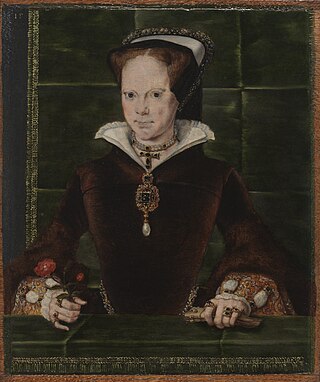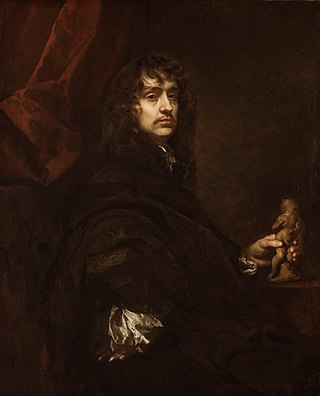Related Research Articles

George Vertue was an English engraver and antiquary, whose notebooks on British art of the first half of the 18th century are a valuable source for the period.

Hans Eworth was a Flemish painter active in England in the mid-16th century. Along with other exiled Flemings, he made a career in Tudor London, painting allegorical images as well as portraits of the gentry and nobility. About 40 paintings are now attributed to Eworth, among them portraits of Mary I and Elizabeth I. Eworth also executed decorative commissions for Elizabeth's Office of the Revels in the early 1570s.

The National Portrait Gallery (NPG) is an art gallery in London that houses a collection of portraits of historically important and famous British people. When it opened in 1856, it was arguably the first national public gallery in the world that was dedicated to portraits.

Sir George Scharf KCB was a British art critic, illustrator, and director of the National Portrait Gallery.

Sir Roy Colin Strong, is an English art historian, museum curator, writer, broadcaster and landscape designer. He has served as director of both the National Portrait Gallery and the Victoria and Albert Museum in London. Strong was knighted in 1982.

Cornelius Johnson was an English painter of portraits of Dutch or Flemish parentage. He was active in England, from at least 1618 to 1643, when he moved to Middelburg in the Netherlands to escape the English Civil War. Between 1646 and 1652 he lived in Amsterdam, before settling in Utrecht, where he died.

Richard Cooper, he was the son of Richard Cooper senior (1701-1764) and his wife Anne Lind.

French hood is the English name for a type of elite woman's headgear that was popular in Western Europe in roughly the first half of the 16th century.

Sir Peter Lely was a painter of Dutch origin whose career was nearly all spent in England, where he became the dominant portrait painter to the court. He became a naturalised British subject and was knighted in 1679.

George Gower was an English portrait painter who became Serjeant Painter to Queen Elizabeth I in 1581.

Michael Sittow, also known as Master Michiel, Michel Sittow, Michiel, Miguel, and several other variants, was a painter from Reval (Tallinn), now capital of Estonia, who was trained in the tradition of Early Netherlandish painting. For most of his life, Sittow worked as a court portrait painter, for Isabella of Castile and her Habsburg relatives in Spain and the Netherlands, and other prominent royal houses. He is considered one of the most important Netherlandish painters of the era.

The artists of the Tudor court are the painters and limners engaged by the monarchs of England's Tudor dynasty and their courtiers between 1485 and 1603, from the reign of Henry VII to the death of Elizabeth I.

The Armada Portrait of Elizabeth I of England is the name of any of three surviving versions of an allegorical panel painting depicting the Tudor queen surrounded by symbols of royal majesty against a backdrop representing the defeat of the Spanish Armada in 1588.

The portraiture of Queen Elizabeth I (1533–1603) spans the evolution of English royal portraits in the early modern period (1400/1500-1800), from the earliest representations of simple likenesses to the later complex imagery used to convey the power and aspirations of the state, as well as of the monarch at its head.

Catherine Howard was Queen of England from July 1540 until November 1541 as the fifth wife of King Henry VIII. She was the daughter of Lord Edmund Howard and Joyce Culpeper, a cousin to Anne Boleyn, and the niece of Thomas Howard, 3rd Duke of Norfolk. Thomas Howard was a prominent politician at Henry's court. He secured her a place in the household of Henry's fourth wife, Anne of Cleves, where Howard caught the King's interest. She married him on 28 July 1540 at Oatlands Palace in Surrey, just 19 days after the annulment of his marriage to Anne. He was 49, and it is widely accepted that she was about 17 at the time of her marriage to Henry VIII.
Susanna(h) A Hornebolt or Horenbout was the first known female artist in England and the Tudor dynasty. The daughter of Flemish artist Gerard Hornebolt and sister of Lucas Horenbout, Susannah learned to paint with her father. She gained recognition in Europe in 1521 when Albrecht Dürer bought her illumination, The Savior.
Tarnya Cooper is an art historian and author who is currently the National Trust's Curatorial & Collections Director.
Philippa Jane Glanville , OBE, FSA, formerly chief curator of the metal, silver and jewellery department of the Victoria and Albert Museum, is an English art historian who is an authority on silver and the history of dining.

Meynnart Wewyck or Maynard Vewicke was a Netherlandish painter, active c. 1502 to 1525 in England and Scotland, where he was known as "Maynard" and "Mynours". Wewyck was employed as an artist at the court of Henry VII of England and, after his death, by his son Henry VIII. He also spent a brief period at the court of James IV of Scotland. Surviving documentation associates Wewyck with portraits of several members of the royal family, and with drawings for the tomb of Lady Margaret Beaufort, mother of Henry VII, at Westminster Abbey. New research published in 2019 has identified a portrait of Lady Margaret Beaufort in the Master's Lodge at St John's College, Cambridge as by Wewyck, and also attributes a painting of Henry VII at the Society of Antiquaries of London to his hand. In follow-on work, a group of researchers suggests that four surviving portraits of Henry VIII and two of his mother, Elizabeth of York, should also be attributed to Wewyck.
Karen Hearn is a British art historian and curator. She has Master's degrees from the University of Cambridge and the University of London. She is an Honorary Professor in the Department of English Language and Literature at the University College London. From 1992 to 2012 Hearn was the Curator of 16th & 17th Century British Art at the Tate where she curated major exhibitions on Tudor and Jacobean paintings, Anthony van Dyck, and Rubens. She was co-curator of Royalist Refugees at The Rubenshuis in Antwerp. She has also curated recent exhibitions at The National Portrait Gallery in London, The Harley Gallery, and The Foundling Museum. She was elected as a Fellow of the Society of Antiquaries of London on 1 January 2005.
References
- 1 2 "Charlotte Bolland". National Portrait Gallery. Retrieved 13 February 2020.
- ↑ Bolland, C. (2011). Italian Material Culture At The Tudor Court (Thesis).
- ↑ "12 December Ballot result". Society of Antiquaries of London. 12 December 2019. Retrieved 13 February 2020.